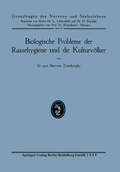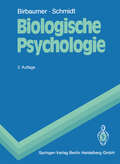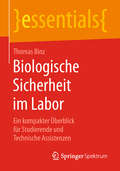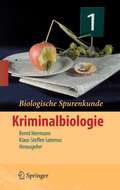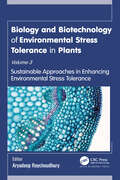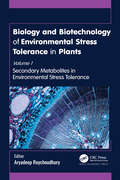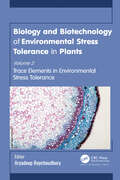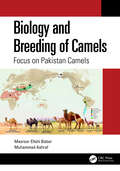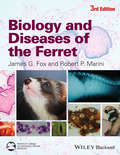- Table View
- List View
Biologische Daten für den Kinderarzt: Grundzüge Einer Biologie des Kindesalters Zweiter Band
by Joachim Brock Erwin Thomas Albrecht PeiperDieser Buchtitel ist Teil des Digitalisierungsprojekts Springer Book Archives mit Publikationen, die seit den Anfängen des Verlags von 1842 erschienen sind. Der Verlag stellt mit diesem Archiv Quellen für die historische wie auch die disziplingeschichtliche Forschung zur Verfügung, die jeweils im historischen Kontext betrachtet werden müssen. Dieser Titel erschien in der Zeit vor 1945 und wird daher in seiner zeittypischen politisch-ideologischen Ausrichtung vom Verlag nicht beworben.
Biologische Korrelate der Angst bei psychiatrischen Erkrankungen (Monographien aus dem Gesamtgebiete der Psychiatrie #67)
by Margot AlbusBiologische Marker bei affektiven Erkrankungen (Monographien aus dem Gesamtgebiete der Psychiatrie #45)
by Helmfried E. KleinBiologische Probleme der Rassehygiene und die Kulturvölker (Grenzfragen des Nerven- und Seelenlebens)
by Stavros ZurukzogluDieser Buchtitel ist Teil des Digitalisierungsprojekts Springer Book Archives mit Publikationen, die seit den Anfängen des Verlags von 1842 erschienen sind. Der Verlag stellt mit diesem Archiv Quellen für die historische wie auch die disziplingeschichtliche Forschung zur Verfügung, die jeweils im historischen Kontext betrachtet werden müssen. Dieser Titel erschien in der Zeit vor 1945 und wird daher in seiner zeittypischen politisch-ideologischen Ausrichtung vom Verlag nicht beworben.
Biologische Psychiatrie: Forschungsergebnisse
by P. Baumann J. Fleischhauer W. Janke B. Küferle D. Ploog B. Saletu1. Dreiländer-Symposium für Biologische Psychiatrie, zugleich 3. Kongreß der Deutschen Gesellschaft für Biologische Psychiatrie. Lindau, 27.-29. September 1984
Biologische Psychiatrie: Synopsis 1986/87
Dieser Band enthält die teilweise überarbeiteten Beiträge zum 4. Kongreß der Deutschen Gesellschaft für Biologische Psychiatrie 1986 in Würzburg. Die Beiträge behandeln die Pathomorphologie endogener Psychosen, psychobiologische Modelle affektiver Erkrankungen, operationalisierte Diagnostik, periphere Marker endogener Psychosen, senile Demenz, klinische Themen, neuropsychobiologische Grundlagen, Psychoendokrinologie, apparative Methoden und die Psychopharmakotherapie.
Biologische Psychiatrie der Gegenwart: 3. Drei-Länder-Symposium für Biologische Psychiatrie Lausanne, September 1992
by W. W. Fleischhacker W. Gaebel G. Laux H. J. Möller B. Saletu B. WoggonDieser Band vereint die wissenschaftlichen Beiträge zum 3. Dreiländersymposium für Biologische Psychiatrie. Damit spiegelt er den gegenwärtigen Stand der Forschung auf dem Gebiet im deutschsprachigen Raum dar. Auffallend ist der stark interdisziplinäre Charakter dieser Veranstaltung, die Psychiater, klinische Pharmakologen, Psychologen, Statistiker, Genetiker, Immunologen und Vertreter der "Neurosciences" vereinigt und Themen der Erwachsenen-, aber auch der Kinder- und Gerontopsychiatrie behandelt. Das Buch ist nach den Hauptthemen gegliedert: Biochemie der Schizophrenie, Chronobiologie und Schlaf, bildgebende Verfahren und Elektrophysiologie, Verlaufsparameter, Opiatabhängigkeit, Kinder-, Jugend- und Gerontopsychiatrie, klinische Psychopharmakologie, neurologische Softsigns, Behandlung und Prophylaxe von affektiven Psychosen, Genetik und Immunologie der Geisteskrankheiten, Psychoneuroendokrinologie. Die 200 Beiträge illustrieren den Aufschwung der biologischen Psychiatrie und sind ein Zeugnis für die intensive Forschung auf diesem Gebiet.
Biologische Psychologie (Springer-Lehrbuch)
by Niels Birbaumer Robert F. SchmidtDer große Erfolg machte bereits nach kurzer Zeit eine Neuauflage notwendig. Die verbesserte 2. Auflage bietet eine übersichtliche und umfassende Einführung in die biologischen und physiologischen Grundlagen des Verhaltens: Von der Einzelzelle bis zu den Denkprozessen wird der neueste Wissensstand dargestellt. Das Gehirn wird dabei nicht nur als biologische Größe betrachtet, die psychisches Erleben und Verhalten "hervorbringt", sondern als ein in ständigem Austausch mit den Umweltgegebenheiten und den vererbten Eigenschaften befindliches dynamisches System. Die didaktisch übersichtliche Darstellung mit zahlreichen hervorragenden Abbildungen erleichtert sowohl dem Anfänger den Einstieg als auch dem Fortgeschrittenen die Aktualisierung seines Wissens. Das Buch ermöglicht somit nicht nur eine ökonomische Prüfungsvorbereitung, sondern führt den Leser zu einem Verständnis des komplexen Zusammenwirkens physiologischer Gesetzmäßigkeiten mit Verhaltensprinzipien.
Biologische Psychologie (Springer-Lehrbuch)
by Niels Birbaumer Robert F. SchmidtDas spannende Fachgebiet Biologische Psychologie erforscht die Zusammenhänge zwischen biologischen Prozessen und Verhalten. Dabei werden die Lebensprozesse aller Organe des Körpers, nicht nur des Gehirns, betrachtet. Das erfolgreiche Lehrbuch "Biologische Psychologie" liefert hier einen lebendigen und anschaulichen Gesamtüberblick sowohl der Physiologie als auch der Physiologischen Psychologie. Die biologischen Grundlagen unseres Verhaltens werden von physiologischen Prozessen bis zu komplexen Funktionen des ZNS, wie Bewusstsein, Motivation und Kognitionen, beschrieben. die engen Beziehungen zwischen "Kopf und Körper" verdeutlichen die Autoren in anschaulicher Weise. Die 6. Auflage wurde komplett überarbeitet und mit lernfreundlicher Didaktik ausgestattet, so dass das Lehrbuch eine unverzichtbare Grundlage für Prüfungsvorbereitung und Studium ist. Hervorgehobene Merksätze und Kapitelzusammenfassungen kennzeichnen prüfungsrelevantes Wissen. Zahlreiche Exkurse und Boxen stellen den Anwendungsbezug her. Die komplett überarbeiteten und durchgehend farbigen Abbildungen veranschaulichen das Zusammenwirken von Verhaltensprinzipien und physiologischen Gesetzmäßigkeiten.
Biologische Psychologie (Springer-Lehrbuch)
by Niels Birbaumer Robert F. SchmidtDas erfolgreiche Lehrbuch bietet eine umfassende Einführung in die biologischen Grundlagen des Verhaltens. Von der Einzelzelle bis zu den Denkvorgängen des Menschen wird der neueste Wissenstand dargestellt. Das Gehirn wird dabei nicht nur als biologische Größe betrachtet, die psychische Prozesse hervorbringt, sondern als ein in ständigem Austausch mit den Umweltgegebenheiten und den vererbten Eigenschaften befindliches dynamisches System. Das Buch besticht durch seine systematische Gliederung und konsequente Didaktik. Jedes Kapitel enthält Einleitungen, strukturierende Überschriften und knappe Zusammenfassungen der wesentlichen Lerninhalte. Somit ermöglicht es nicht nur eine ökonomische Prüfungsvorbereitung, sondern führt den Leser zu einem Verständnis des komplexen Zusammenwirkens von Verhaltensprinzipien und physiologischen Gesetzmäßigkeiten.
Biologische Psychologie (Springer-Lehrbuch)
by Niels Birbaumer Robert F. SchmidtBiologische Psychologie, das erfolgreiche Lehrbuch von Robert F. Schmidt und Niels Birbaumer, liegt in der 5. Auflage vor. Die biologischen Grundlagen unseres Verhaltens werden von physiologischen Prozessen bis zu komplexen Funktionen des ZNS, wie Bewusstsein, Motivation und Kognitionen, beschrieben. Neue Methoden der Biopsychologie und aktuelle Forschungsergebnisse wurden ergänzt. Die Didaktik des Lehrbuches macht es zu einer unverzichtbaren Grundlage für Prüfungsvorbereitung und Studium. Kapitelzusammenfassungen und Infoboxen kennzeichnen prüfungsrelevantes Wissen. Zahlreiche Abbildungen veranschaulichen das Zusammenwirken von Verhaltensprinzipien und physiologischen Gesetzmäßigkeiten.
Biologische Rhythmen und Arbeit: Bausteine zur Chronobiologie und Chronohygiene der Arbeitsgestaltung
by Gunther HildebrandtBiologische Sicherheit im Labor: Ein kompakter Überblick für Studierende und Technische Assistenzen (essentials)
by Thomas BinzIn kurzer und anschaulicher Weise gibt Thomas Binz einen Überblick über die biologische Sicherheit im Laborbereich. Die wichtigsten Elemente, wie die Zuteilung der Mikroorganismen zu Risikogruppen, die Bewertung der Risiken bei der Erzeugung von genetisch veränderten Mikroorganismen und die Elemente des Laboratoriums, die im Hinblick auf die biologische Sicherheit besonders relevant sind, werden unter Berücksichtigung der europäischen gesetzlichen Grundlagen dargestellt. Aufgrund des hohen Stellenwerts der Risikobewertung wird detailliert auf dieses Verfahren einschließlich anschaulicher Beispiele eingegangen. Das Buch soll nicht nur einen Überblick über die biologische Sicherheit geben, sondern auch zu ihrem Verständnis beitragen.Der AutorDr. Thomas Binz geht einer behördlichen Tätigkeit im Bereich Biologische Sicherheit nach (Bewilligungswesen, Abschätzung biologischer Risiken gentechnisch veränderter Organismen, nationale und internationale Rechtssetzung, Biowaffenkonvention). Er ist in verschiedenen nationalen und internationalen Ausbildungsprogrammen (Schweizerisches Biosafety Curriculum, Europäische Gesellschaft für Biosicherheit) eingebunden und unterrichtet im Rahmen des französischen 'Diplôme universitaire' für Biosicherheit der Universität Lille.
Biologische Spurenkunde: Band 1: Kriminalbiologie
by Bernd Herrmann Klaus-Steffen SaternusExperten geben erstmals einen Überblick über die biowissenschaftlichen Grundlagen spurenkundlicher Arbeit sowie ihrer hauptsächlichen Tätigkeitsfelder. In Übersichtsaufsätzen werden die jeweiligen Fragestellungen und die verwendeten Methoden dieser Arbeitsbereiche vorgestellt.
Biologische Vielfalt Perspektiven für das Neue Jahrhundert: Erkenntnisse aus dem Schweizer Biodiversitätsprojekt
by Gregor Klaus Jörg Schmill Bernhard Schmid Peter J. EdwardsDie biologische Vielfalt unseres Planeten ist zum zentralen Thema für das Überleben der Menschheit geworden. Dieses leicht verständliche Buch beleuchtet den Wissensstand und stellt die aktuellen Forschungsresultate aus dem Schweizer Biodiversitätsprojekt vor. Darin haben über 50 Wissenschaftlerinnen und Wissenschaftler während acht Jahren Wege zur Erhaltung unserer bedrohten biologischen Vielfalt untersucht. Die Autoren analysieren die Situation in der Schweiz und zeigen auf, was zu tun ist, damit wir auch in Zukunft in einer reichen Natur leben können.
Biology and Biotechnology of Environmental Stress Tolerance in Plants: Volume 3: Sustainable Approaches for Enhancing Environmental Stress Tolerance
by Aryadeep RoychoudhuryAbiotic stresses such as drought, high salt, cold, heat, UV radiation, heavy metal pollution, etc., are increasingly responsible for restricting plant growth and agricultural production and are becoming more alarming due to threats from global climate change. To combat these threats, this new 3-volume set provides a comprehensive understanding of the mechanisms that mediate biosynthesis, accumulation, and degradation of plant metabolites to improve crop production and enhance abiotic stress tolerance in plants. Volume 1: Secondary Metabolites in Environmental Stress Tolerance focuses exclusively on the diverse secondary metabolites that play a major role in the adaptation of plants to the environment and in overcoming stress conditions as well as their implications for enhancing tolerance mechanisms. The book presents information on the protective role rendered by a wide array of antioxidative secondary metabolites and their regulation during diverse environmental stress. Volume 2: Trace Elements in Environmental Stress Tolerance throws light on the different inorganic trace elements, including metal nanoparticles, that help to deal with environmental stresses. While these elements at high level create considerable phytotoxicity and halt metabolic and enzymatic activity, they also promote growth and development in limited quantity, so that they have significant potential in revamping plant morphology and physiology under stressed conditions. Hence, optimum concentration management of these elements can help to mitigate world hunger and contribute toward sustainable agriculture and food security under challenging environments. Volume 3: Sustainable Approaches for Enhancing Environmental Stress Tolerance focuses on the agronomic and biochemical approaches as well as biotechnological and high-throughput technologies, including the prospects of genetic engineering, epigenetics and the latest CRISPR/Cas technology, in generating stress-tolerant plants. The volume provides a clear roadmap for the implementation of techniques for improving abiotic stress tolerance in plants for better sustenance.
Biology and Biotechnology of Environmental Stress Tolerance in Plants: Volume 1: Secondary Metabolites in Environmental Stress Tolerance
by Aryadeep RoychoudhuryAbiotic stresses such as drought, high salt, cold, heat, UV radiation, heavy metal pollution, etc., are increasingly responsible for restricting plant growth and agricultural production and are becoming more alarming due to threats from global climate change. To combat these threats, this new 3-volume set provides a comprehensive understanding of the mechanisms that mediate biosynthesis, accumulation, and degradation of plant metabolites to improve crop production and enhance abiotic stress tolerance in plants. Volume 1: Secondary Metabolites in Environmental Stress Tolerance focuses exclusively on the diverse secondary metabolites that play a major role in the adaptation of plants to the environment and in overcoming stress conditions as well as their implications for enhancing tolerance mechanisms. The book presents available information on the protective roles rendered by a wide array of antioxidative secondary metabolites and their regulation during diverse environmental stress. Volume 2: Trace Elements in Environmental Stress Tolerance throws light on the different inorganic trace elements, including metal nanoparticles, that help to deal with environmental stresses. While these elements at high level create considerable phytotoxicity and halt metabolic and enzymatic activity, they also promote growth and development in limited quantity, so that they have significant potential in revamping plant morphology and physiology under stressed conditions. Hence, optimum concentration management of these elements can help to mitigate world hunger and contribute toward sustainable agriculture and food security under challenging environments. Volume 3: Sustainable Approaches for Enhancing Environmental Stress Tolerance focuses on the agronomic and biochemical approaches as well as biotechnological and high-throughput technologies, including the prospects of genetic engineering, epigenetics and the latest CRISPR/Cas technology, in generating stress-tolerant plants. The volume provides a clear roadmap for the implementation of techniques for improving abiotic stress tolerance in plants for better sustenance.
Biology and Biotechnology of Environmental Stress Tolerance in Plants: Volume 2: Trace Elements in Environmental Stress Tolerance
by Aryadeep RoychoudhuryAbiotic stresses such as drought, high salt, cold, heat, UV radiation, heavy metal pollution, etc., are increasingly responsible for restricting plant growth and agricultural production and are becoming more alarming due to threats from global climate change. To combat these threats, this new 3-volume set provides a comprehensive understanding of the mechanisms that mediate biosynthesis, accumulation, and degradation of plant metabolites to improve crop production and enhance abiotic stress tolerance in plants. Volume 1: Secondary Metabolites in Environmental Stress Tolerance focuses exclusively on the diverse secondary metabolites that play a major role in the adaptation of plants to the environment and in overcoming stress conditions as well as their implications in enhancing tolerance mechanisms. The book presents information on the protective roles rendered by a wide array of antioxidative secondary metabolites and their regulation during diverse environmental stress. Volume 2: Trace Elements in Environmental Stress Tolerance throws light on the different inorganic trace elements, including metal nanoparticles, that help to deal with various environmental stresses. While these elements at high level create considerable phytotoxicity and halt metabolic and enzymatic activity, they also promote growth and development in limited quantity, so that they have significant potential in revamping plant morphology and physiology under stressed conditions. Hence, optimum concentration management of these elements can help to mitigate world hunger and contribute toward sustainable agriculture and food security under challenging environments. Volume 3: Sustainable Approaches for Enhancing Environmental Stress Tolerance focuses on agronomic and biochemical approaches as well as biotechnological and high-throughput technologies, including the prospects of genetic engineering, epigenetics and the latest CRISPR/Cas technology in generating stress-tolerant plants. The volume provides a clear roadmap for the implementation of techniques for improving abiotic stress tolerance in plants for better sustenance.
Biology and Biotechnology of Environmental Stress Tolerance in Plants: Volume 3: Sustainable Approaches for Enhancing Environmental Stress Tolerance
Abiotic stresses such as drought, high salt, cold, heat, UV radiation, heavy metal pollution, etc., are increasingly responsible for restricting plant growth and agricultural production and are becoming more alarming due to threats from global climate change. To combat these threats, this new 3-volume set provides a comprehensive understanding of the mechanisms that mediate biosynthesis, accumulation, and degradation of plant metabolites to improve crop production and enhance abiotic stress tolerance in plants. Volume 1: Secondary Metabolites in Environmental Stress Tolerance focuses exclusively on the diverse secondary metabolites that play a major role in the adaptation of plants to the environment and in overcoming stress conditions as well as their implications for enhancing tolerance mechanisms. The book presents information on the protective role rendered by a wide array of antioxidative secondary metabolites and their regulation during diverse environmental stress. Volume 2: Trace Elements in Environmental Stress Tolerance throws light on the different inorganic trace elements, including metal nanoparticles, that help to deal with environmental stresses. While these elements at high level create considerable phytotoxicity and halt metabolic and enzymatic activity, they also promote growth and development in limited quantity, so that they have significant potential in revamping plant morphology and physiology under stressed conditions. Hence, optimum concentration management of these elements can help to mitigate world hunger and contribute toward sustainable agriculture and food security under challenging environments. Volume 3: Sustainable Approaches for Enhancing Environmental Stress Tolerance focuses on the agronomic and biochemical approaches as well as biotechnological and high-throughput technologies, including the prospects of genetic engineering, epigenetics and the latest CRISPR/Cas technology, in generating stress-tolerant plants. The volume provides a clear roadmap for the implementation of techniques for improving abiotic stress tolerance in plants for better sustenance.
Biology and Biotechnology of Environmental Stress Tolerance in Plants: Volume 1: Secondary Metabolites in Environmental Stress Tolerance
Abiotic stresses such as drought, high salt, cold, heat, UV radiation, heavy metal pollution, etc., are increasingly responsible for restricting plant growth and agricultural production and are becoming more alarming due to threats from global climate change. To combat these threats, this new 3-volume set provides a comprehensive understanding of the mechanisms that mediate biosynthesis, accumulation, and degradation of plant metabolites to improve crop production and enhance abiotic stress tolerance in plants. Volume 1: Secondary Metabolites in Environmental Stress Tolerance focuses exclusively on the diverse secondary metabolites that play a major role in the adaptation of plants to the environment and in overcoming stress conditions as well as their implications for enhancing tolerance mechanisms. The book presents available information on the protective roles rendered by a wide array of antioxidative secondary metabolites and their regulation during diverse environmental stress. Volume 2: Trace Elements in Environmental Stress Tolerance throws light on the different inorganic trace elements, including metal nanoparticles, that help to deal with environmental stresses. While these elements at high level create considerable phytotoxicity and halt metabolic and enzymatic activity, they also promote growth and development in limited quantity, so that they have significant potential in revamping plant morphology and physiology under stressed conditions. Hence, optimum concentration management of these elements can help to mitigate world hunger and contribute toward sustainable agriculture and food security under challenging environments. Volume 3: Sustainable Approaches for Enhancing Environmental Stress Tolerance focuses on the agronomic and biochemical approaches as well as biotechnological and high-throughput technologies, including the prospects of genetic engineering, epigenetics and the latest CRISPR/Cas technology, in generating stress-tolerant plants. The volume provides a clear roadmap for the implementation of techniques for improving abiotic stress tolerance in plants for better sustenance.
Biology and Biotechnology of Environmental Stress Tolerance in Plants: Volume 2: Trace Elements in Environmental Stress Tolerance
Abiotic stresses such as drought, high salt, cold, heat, UV radiation, heavy metal pollution, etc., are increasingly responsible for restricting plant growth and agricultural production and are becoming more alarming due to threats from global climate change. To combat these threats, this new 3-volume set provides a comprehensive understanding of the mechanisms that mediate biosynthesis, accumulation, and degradation of plant metabolites to improve crop production and enhance abiotic stress tolerance in plants. Volume 1: Secondary Metabolites in Environmental Stress Tolerance focuses exclusively on the diverse secondary metabolites that play a major role in the adaptation of plants to the environment and in overcoming stress conditions as well as their implications in enhancing tolerance mechanisms. The book presents information on the protective roles rendered by a wide array of antioxidative secondary metabolites and their regulation during diverse environmental stress. Volume 2: Trace Elements in Environmental Stress Tolerance throws light on the different inorganic trace elements, including metal nanoparticles, that help to deal with various environmental stresses. While these elements at high level create considerable phytotoxicity and halt metabolic and enzymatic activity, they also promote growth and development in limited quantity, so that they have significant potential in revamping plant morphology and physiology under stressed conditions. Hence, optimum concentration management of these elements can help to mitigate world hunger and contribute toward sustainable agriculture and food security under challenging environments. Volume 3: Sustainable Approaches for Enhancing Environmental Stress Tolerance focuses on agronomic and biochemical approaches as well as biotechnological and high-throughput technologies, including the prospects of genetic engineering, epigenetics and the latest CRISPR/Cas technology in generating stress-tolerant plants. The volume provides a clear roadmap for the implementation of techniques for improving abiotic stress tolerance in plants for better sustenance.
Biology and Breeding of Camels: Focus on Pakistan Camels
by Masroor Ellahi Babar Muhammad AshrafThis book discusses the biology, breeding, care, and management of camels, with a focus on camels from Pakistan. The book provides a sound understanding of how to look after camels, their senses, behavior, and adaptations. The chapters describe the practical aspects of camel husbandry such as how to maintain their body condition, feet, and cleanliness. It covers the types of feeds, feeding methods, and their needs at different stages of life. The book provides a detailed account of camel husbandry, breeding, and reproduction. It is meant for camel breeders, veterinarians, livestock advisers, students, and researchers working on animal sciences, camel rearing, feeding, and management.FEATURES Includes information about different species of camels present in Pakistan and their importance to humans Discusses the nutrition and feeding of camels, the medicinal qualities of camel milk, and the peculiar immunity-enhancing properties of their nutritious meat Describes the features of camels that help them survive and thrive in deserts and make them the animals of the future Covers the range of unique products obtained from camels and their economic value Explores the management, types of diseases in camels, causes of their spread, their control, and therapeutic measures for successful and productive farming
Biology and Breeding of Camels: Focus on Pakistan Camels
by Masroor Ellahi Babar Muhammad AshrafThis book discusses the biology, breeding, care, and management of camels, with a focus on camels from Pakistan. The book provides a sound understanding of how to look after camels, their senses, behavior, and adaptations. The chapters describe the practical aspects of camel husbandry such as how to maintain their body condition, feet, and cleanliness. It covers the types of feeds, feeding methods, and their needs at different stages of life. The book provides a detailed account of camel husbandry, breeding, and reproduction. It is meant for camel breeders, veterinarians, livestock advisers, students, and researchers working on animal sciences, camel rearing, feeding, and management.FEATURES Includes information about different species of camels present in Pakistan and their importance to humans Discusses the nutrition and feeding of camels, the medicinal qualities of camel milk, and the peculiar immunity-enhancing properties of their nutritious meat Describes the features of camels that help them survive and thrive in deserts and make them the animals of the future Covers the range of unique products obtained from camels and their economic value Explores the management, types of diseases in camels, causes of their spread, their control, and therapeutic measures for successful and productive farming
Biology and Diseases of the Ferret
by James G. Fox Robert P. MariniBiology and Diseases of the Ferret, Third Edition has been thoroughly revised and updated to provide a current, comprehensive reference on the ferret. Encyclopedic in scope, it is the only book to focus on the characteristics that make the ferret an important research animal, with detailed information on conditions, procedures, and treatments. Offering basic information on biology, husbandry, clinical medicine, and surgery, as well as unique information on the use of ferrets in biomedical research, Biology and Diseases of the Ferret is an essential resource for investigators using ferrets in the laboratory and for companion animal and comparative medicine veterinarians. The Third Edition adds ten completely new chapters, covering regulatory considerations, black-footed ferret recovery, diseases of the cardiovascular system, viral respiratory disease research, morbillivirus research, genetic engineering, hearing and auditory function, vision and neuroplasticity research, nausea and vomiting research, and lung carcinogenesis research. Additionally, the anesthesia, surgery, and biomethodology chapter has been subdivided into three and thoroughly expanded. The book also highlights the ferret genome project, along with the emerging technology of genetically engineered ferrets, which is of particular importance to the future of the ferret as an animal model in research and will allow the investigation of diseases and their genetic basis in a small, easily maintained, non-rodent species.



